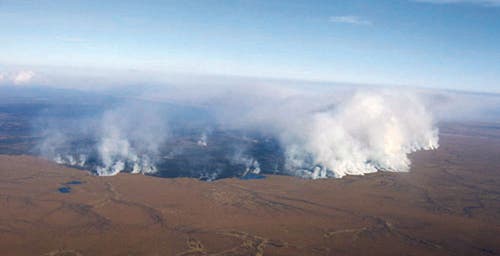
Studying the immense 2007 Anaktuvuk River fire, which burned 401 square miles and becoming the largest tundra fire on record, scientists have found that more carbon was spewed into the air in a few months than the entire Arctic tundra ecosystem normally absorbs in an average year.
For the past 10,000 years tundra fires have been an uncommon sight, until the past decade or so when it became quite frequent as the climate warmed. Anaktuvuk River fire on Alaska’s North Slope dumped some 2.3 million tons of carbon into the atmosphere, roughly twice the amount of greenhouse gases emitted by Miami in a single year, and almost certainly enough to help hurry the rate of climate warming in the Arctic.
This happened because of the carbon rich soil, containing some layer as old as 50 years, on which the tundra grew. Thus the highly combustible soil made for a perfect base for the fire.
“The 2007 fire was the canary in the coal mine,” said ecologist Michelle Mack. “In this wilderness, hundreds of miles away from the nearest city or source of pollution, we’re seeing the effects of a warming atmosphere. It’s a wakeup call that the Arctic carbon cycle could change rapidly, and we need to know what the consequences will be.”
Nature’s pollution can be just as bad as human one
Not only did the wildfire cause a huge single emission of carbon into the environment, but also an equally devastating permafrost (permanently frozen groun) exposure now vulnerable to thawing, creating sinkholes and gullies known as thermokast.
RELATED: Soot responsible for rapid Arctic melting?
“When the permafrost warms, microbes will begin to decompose that organic matter and could release even more carbon that’s been stored in the permafrost for hundreds or thousands of years into the atmosphere,” says Mack. “If that huge stock of carbon is released, it could increase atmospheric carbon dioxide drastically.”
The University of Florida study show through the authors’ observations of carbon loss from the Anaktuvuk River fire, that tundra fires have the potential to release large amounts of carbon and decrease landscape carbon stocks, having an immediate impact on atmospheric carbon and climate.





